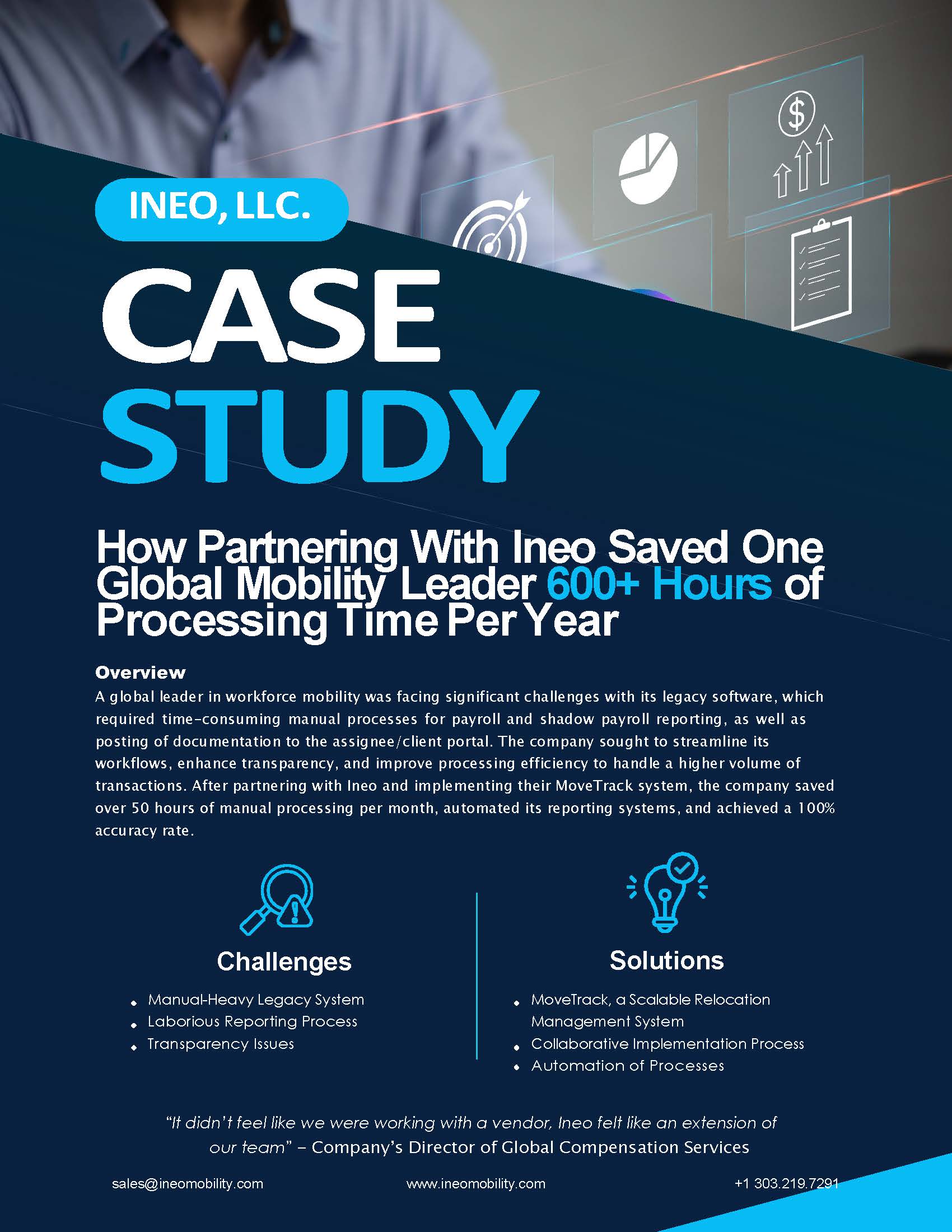5 Best Practices to Optimize Your Global Mobility Program

Let’s say your company is about to make a $3 million investment. If it’s to buy new equipment, you’d consult engineers to research and review the field of relevant products and vendors. If it’s a financial investment, you’d call-in analysts in the particular asset categories involved. And then after you made the investment, you’d continually track its performance.
But what if that $3 million investment is sending an executive on international assignment? According to a report by the Society for Human Resource Management (SHRM) there’s a lot of room for improvement in the way costly global mobility programs are being managed today.
“International assignment management is one of the hardest areas for HR professionals to master—and one of the most costly. The cost of a three-year international assignment can easily exceed $3 million, yet many organizations fail to get it right.”
Some specifics:
- There’s an overall 42% failure rate for international assignments; meaning they didn’t achieve management’s objectives.
- 22% of U.S. based companies, and 18% overall, give their employees little or no training prior to an international assignment.
- When it comes to financial accounting of international assignments:
- 76% of companies do not compare actual vs. estimated cost
- 49% don’t track actual expenses at all
- 94% fail to calculate Return on Investment.
Fortunately, there’s a growing community of global mobility experts addressing these problems. Here’s the story of two of them.
Meet Kay Ironside and Holly Maria Creed of DXC Technology.
Kay Ironside is UK Global Mobility Lead, and Holly Maria Creed is a Global Mobility Manager, of DXC Technology – the world’s leading independent, end-to-end IT services company, with 130,000 employees and 6,000 clients in over 70 countries.
If the DXC name doesn’t sound familiar, it is because it’s a new brand emerging from the 2017 merger of two storied technology companies: Computer Sciences Corporation (CSC) and Hewlett Packard (HP) Enterprise Services. The latter firm incorporates still another world-famous name, Electronic Data Services (EDS), resulting from its 2008 acquisition by HP.
As a testament to their success in bringing best practices to global mobility, Kay and Holly alongside the other members of the UKI and Europe GM Team were recently honored by the Forum for Expatriate Management’s EMMA Award for Team of the Year (Large Program).
Ineo LLC, recently spoke with Kay and Holly in their London offices, where they are currently enmeshed in an enterprise-wide project to reorganize their company’s global mobility processes following the 2017 merger.
Here’s a summary of their advice to colleagues around the world about optimizing global mobility programs.
1. Improve the employee experience
INEO: Have you been able to quantify the failure of an assignment? I mean, if you send somebody overseas and they were supposed to be out there for a three to five-year assignment, and six months in, they’re telling you, “My family can’t handle this. I can’t handle this. I’m coming home.”
KAY: We don’t yet have the technology to track that data – we’re working on it – but we know the cost of failure is high. So, what we’re doing in the meantime is to actually increase the cost of an assignment by a small amount to enhance the employee experience.
HOLLY: I think this is so important! While we’re always looking at cost optimizations, the one place we know we need to spend more is to have a functioning employee when they arrive in the host country. By investing a little extra at the beginning, we’re going to maximize business return through revenue. We don’t want them wasting billable time finding housing or filling out bank account forms.
INEO: I couldn’t agree more that mobility programs shouldn’t underestimate the importance of helping the employee’s spouse find a job. According to SHRM, the spouse’s unhappiness is a leading cause of assignment failure. Trailing spouses really need services, and today that includes the 80% who want to work at least part time, even though local laws can make that a challenge.
2. Deliver better return on investment, not just lower cost
INEO: Speaking of cost optimization, how do you justify the high expenses inherent in international relocation?
HOLLY: We had a merger last year, and since then, we have been very conscious of costs, but we have to realize that we can’t just keep chopping things out of a global mobility policy. We have to be practical and realistic to understand true costs and what will actually still make the right people go on assignment.
For example, we rely heavily on the technology talent in India, and that means we are often sending our Indian employees to deliver a hands-on service to our clients elsewhere in the world. If we don’t spend the money, then we can’t move employees. We obviously want to do the best for our clients, so we move our talent where it’s needed to help our clients with their technology journeys.
INEO: We discussed the idea of spending a little more in up-front employee support, to maximize business return by getting an employee up to speed faster. We also talked about the importance of technology in tracking cost and service consistency across the enterprise. Calculating Return on Investment is where these two thoughts converge. In other words, you need good data to prove when and where spending extra money generates the greater return.
3. Deploy the right technology
INEO: No doubt technology plays a critical role in tracking cost and service consistency across the enterprise. For example: estimating costs of an international transfer, and tracking actual costs against estimate, are core functions of our TechSuite package. We understand that your company plans to deploy new software to manage the global mobility function overall. What are you expecting new technology to do to maximize your mobility program?
KAY: We need tools to deliver consistent processes globally. We operate in between 70 and 90 countries. We don’t have global mobility professionals in all those places – just regional service centers in various countries, but they’re not always working consistently. So, we really need to assure consistency in the policies and benefits we offer. We need to have good data, and good reporting, that all helps us to deliver a better employee experience.
HOLLY: We’re also automating our business compliance and tracker program. We’re close to launching a pilot and then going worldwide a month later, and that is going to automate the entire business visitor process, including getting an invite letter to do your visa. Technology will save us money through better business travel purchasing and tax planning. It’s going to really empower us to have more entrepreneurial and strategic conversations with the business vs. asking, “We need a payment made now, because you’ve got a tax liability.”
4. Consolidate vendors
INEO: You certainly must rely on a lot of vendors to deliver global mobility services: movers, relocation management companies, destination service providers and so on. How do you optimize prices and service levels?
HOLLY: At present, we have over 80 vendors. It’s obviously a big number, so we are looking to get them down to seven core vendors. As part of that, we are actually doing an RFP at present for a relocation management company. We’re currently going through 6 submissions to pick one vendor to work with us worldwide.
INEO: If we could make one other point here: when consolidating vendors, you need to track how current suppliers are performing, both in terms of cost and service quality as measured, for example, by complaints and satisfaction surveys. Our TechSuite software has a vendor and partner management module designed to assemble this data.
5. Build a flexible policy suite
INEO: You’re currently in the process of standardizing – or “harmonizing” – the global mobility policies and processes as a result of the merger across a huge workforce spanning 70 countries. How do you do this? Do you first get input from stakeholders within the company?
KAY: Yes, that input is very important. It was quite challenging to get it, especially from our senior leadership team, because they’re obviously very busy people. But at the end of the day, it was essential for us to start our journey with the right insights to create our framework.
So, we’re looking at offering a flexible policy suite, so we’ll have our core benefits, which are mainly compliance, but then discretionary benefits, which are available to actually suit the experience of the employees, the type of their assignment, the reason for their assignment, their family circumstances.
INEO: Thanks, Kay and Holly, for all your excellent advice. We wish you success in implementing your new global mobility program at DXC Technology.
About Ineo
Ineo provides software and services for many of the world’s corporations and relocation management companies to effectively manage their employee global mobility programs. To reduce risk and ensure compliance, organizations facing complex mobility challenges rely on our unique combination of pioneering global mobility software, reliable expense processing outsourced services, and comprehensive tax preparation and consultation services.
Global Mobility Resources
Learn more about what’s going on at Ineo and insights into the complex world of global mobility from the industry’s top thought leaders and innovators.
Request A Demo
Whether you are new to the world of global mobility or you’ve been in the business for a while, Ineo is here to assist you.
The best way to learn how Ineo’s global mobility software can help your company revolutionize your global mobility program and support your business strategy is to see it in a demo.
Fill out this form to get started today.
Get Started






